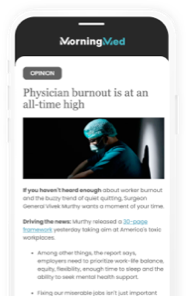
A-Fib Patients Younger Than 65 Face Heightened Risk for Heart-Related Hospitalization

TUESDAY, May 7, 2024 (HealthDay News) -- Patients younger than 65 years with atrial fibrillation (AF) have a significant burden of risk factors and comorbidities, as well as heightened risk for hospitalization for cardiovascular events, according to a study published online April 22 in Circulation: Arrhythmia and Electrophysiology.
Aditya Bhonsale, M.D., from the University of Pittsburgh Medical Center, and colleagues examined the association between AF and all-cause mortality among 918,073 individuals aged younger than 65 years without AF.
The researchers found that during a mean follow-up of more than five years, the proportion of patients with one or more hospitalization for myocardial infarction, heart failure, and stroke was 1.3, 4.8, and 1.1 percent, respectively, for those aged younger than 50 years and 2.2, 7.4, and 1.1 percent, respectively, for those ages 50 to 65 years. Increased mortality in younger patients with AF with heart failure and hypertension was associated with multiple cardiac and noncardiac risk factors, illustrating a significant age-related interaction. Significantly worse survival was seen among patients with AF aged younger than 65 years compared with comorbidity-adjusted patients without AF (men aged younger than 50 years: hazard ratio [HR], 1.5; men aged 50 to 65 years: HR, 1.3; women aged younger than 50 years: HR, 2.4; women aged 50 to 65 years: HR, 1.7). Cardiovascular risk factors among individuals younger than 65 years with AF included current smoker status (16 percent), high body mass index (mean, 33.0), hypertension (55 percent), diabetes (21 percent), heart failure (20 percent), coronary artery disease (19 percent), and prior ischemic stroke (6 percent), while comorbidities included chronic obstructive pulmonary disease (11 percent), obstructive sleep apnea (18 percent), and chronic kidney disease (1.3 percent).
"These patients warrant an aggressive focus on risk factor and comorbidity evaluation and management," the authors write.
Several authors disclosed ties to the medical technology industry.



